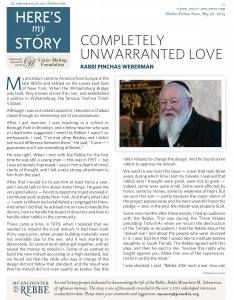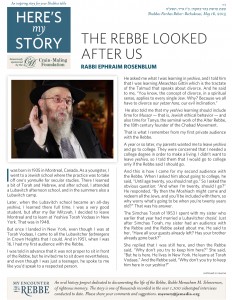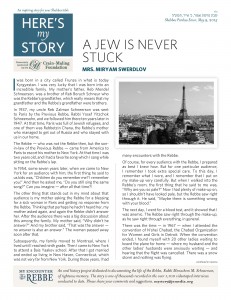My ancestors came to America from Europe in the late 1800s and settled on the Lower East Side of New York. When the Williamsburg Bridge was built, they moved across the river, and established a yeshiva in Williamsburg, the famous Yeshiva Torah Vodaas.
Although I was not raised Lubavitch, I became a Chabad chasid through an interesting set of circumstances.
After I got married, I was teaching school in Borough Park in Brooklyn, and a fellow teacher who was a Lubavitcher suggested I meet his Rebbe. I wasn’t so enthusiastic. I said, “I’ve met other Rebbes and I didn’t see much difference between them.” He said, “Come – I guarantee you’ll see something different.”
He was right. When I met with the Rebbe for the first time he was still a young man – this was in 1957 – but I was extremely impressed. I saw in him a depth of mind, clarity of thought, and I felt a very strong attachment to him from the start.
After that I would try to see him at least twice a year, and I would talk to him about many things. He gave me very good advice – he encouraged me to get involved in communal work outside New York. And that’s what I did – I went to Miami and established a congregation there. And when I did that, he advised me on how to handle the donors, how to handle the board of directors and how to handle other rabbis in the community.
There came a time, in 1970, when I realized that we needed to rebuild the local mikvah. It had been built thirty years prior, when proper building materials were not available due to the war, and it was starting to deteriorate. So several local rabbis got together, and we raised the money to rebuild it. Some of us wanted to build the new mikvah according to a high standard, but we found out that the rabbi who was in charge of the design did not follow that standard, and the result was that his mikvah did not even qualify as kosher. But this rabbi refused to change the design. And he found some rabbis to approve his mikvah. (more…)








